Analysis of Judgement and Decision Making: Abstract Assignment (49001)
VerifiedAdded on 2023/01/13
|10
|2420
|71
Homework Assignment
AI Summary
This assignment presents an analysis of judgment and decision-making through four abstracts, referencing key articles by Fischoff, Slovic, and Lichtenstein (1980), Hogarth (1981), Jackall (1988), and Linstone (1984). The first abstract examines the challenges in understanding values and the impact of emotional lability on judgments. The second explores the limitations of discrete decision models and the importance of continuous processes in decision-making. The third abstract discusses the role of authority and decision-making in managerial contexts. The fourth abstract introduces the concept of multiple perspectives in decision-making, using organizational, technical, and personal filters. Each abstract is followed by personal observations and examples, connecting theoretical concepts to real-world scenarios. The assignment demonstrates an understanding of the complexities of human judgment and decision-making processes, and their practical implications.
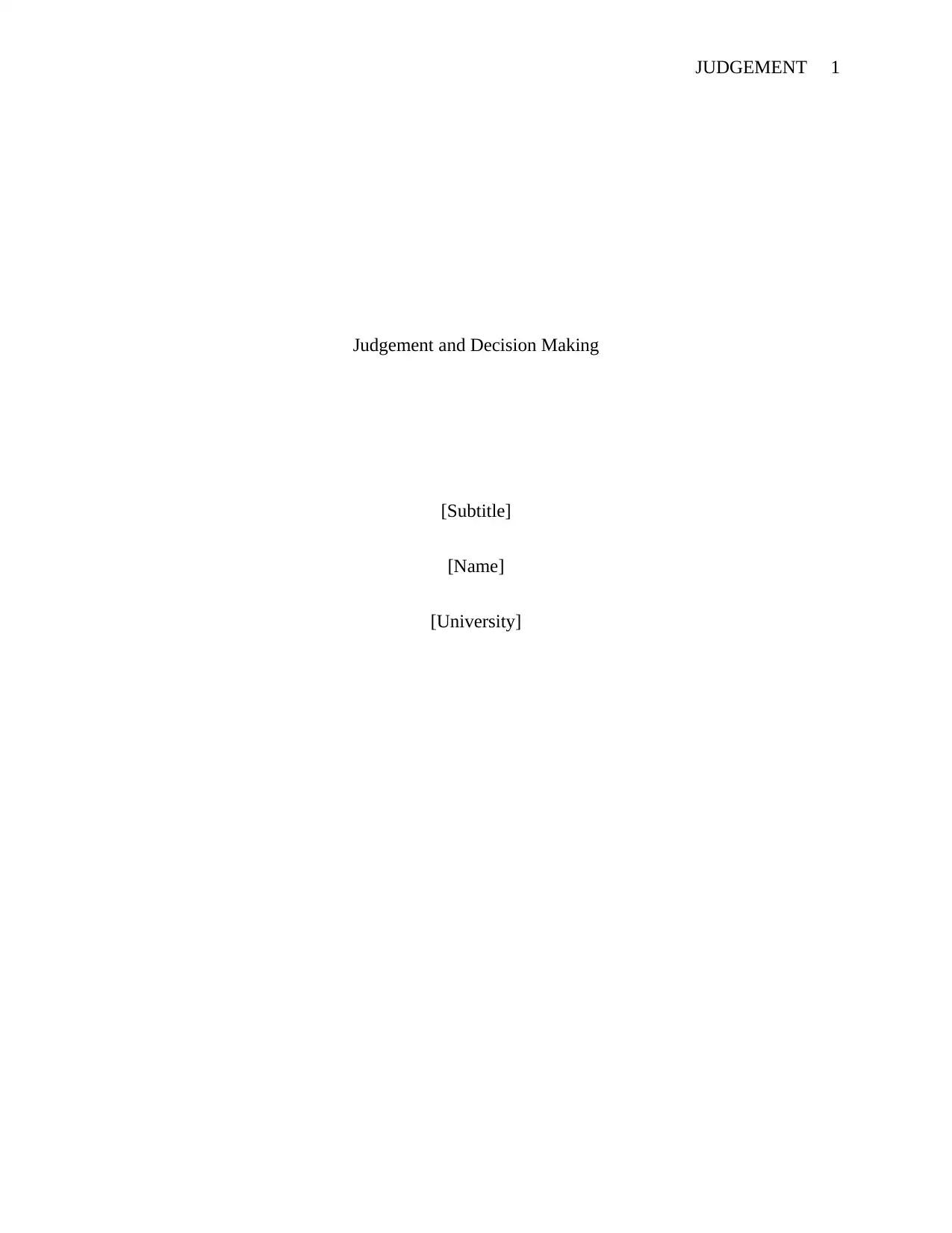
JUDGEMENT 1
Judgement and Decision Making
[Subtitle]
[Name]
[University]
Judgement and Decision Making
[Subtitle]
[Name]
[University]
Paraphrase This Document
Need a fresh take? Get an instant paraphrase of this document with our AI Paraphraser
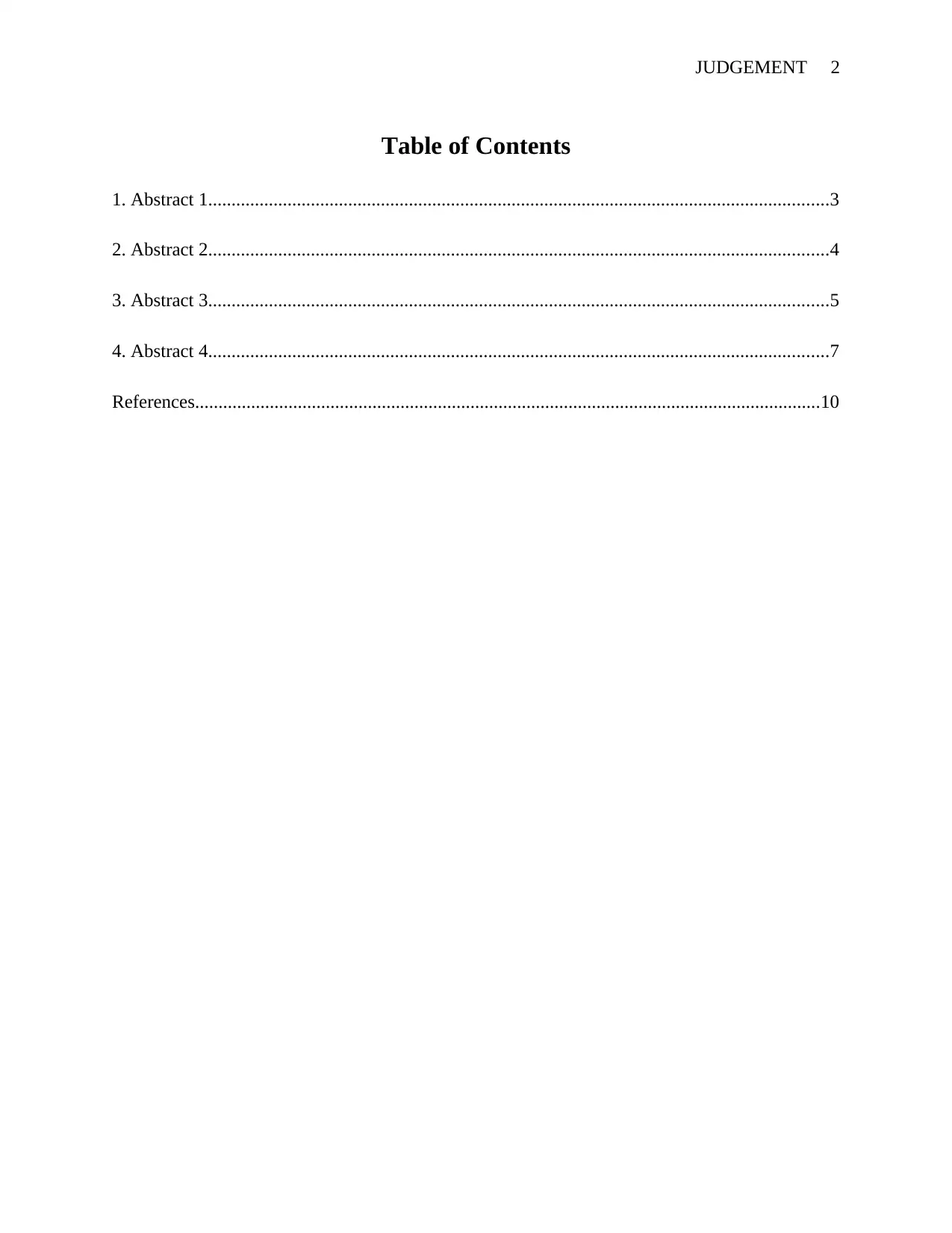
JUDGEMENT 2
Table of Contents
1. Abstract 1.....................................................................................................................................3
2. Abstract 2.....................................................................................................................................4
3. Abstract 3.....................................................................................................................................5
4. Abstract 4.....................................................................................................................................7
References......................................................................................................................................10
Table of Contents
1. Abstract 1.....................................................................................................................................3
2. Abstract 2.....................................................................................................................................4
3. Abstract 3.....................................................................................................................................5
4. Abstract 4.....................................................................................................................................7
References......................................................................................................................................10
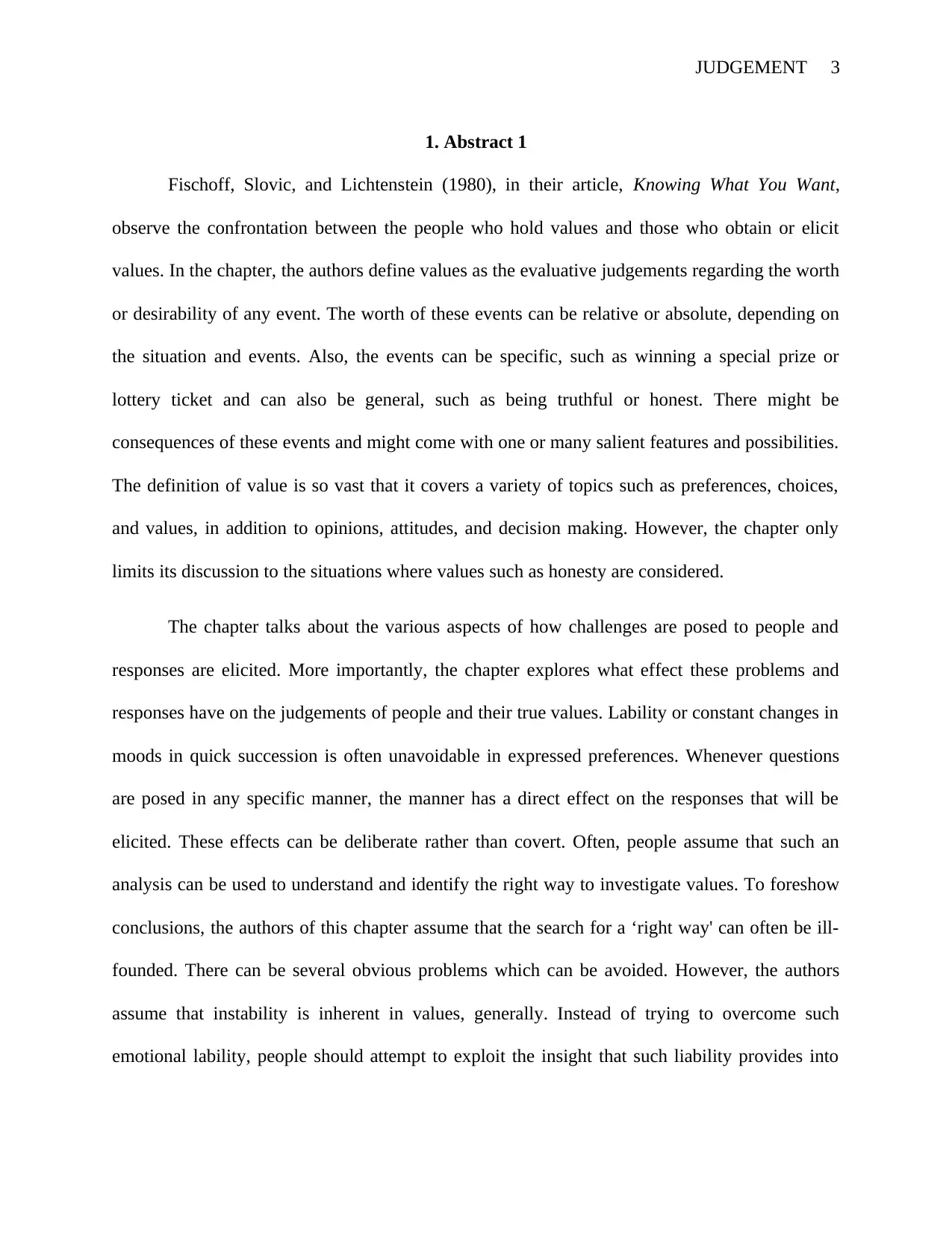
JUDGEMENT 3
1. Abstract 1
Fischoff, Slovic, and Lichtenstein (1980), in their article, Knowing What You Want,
observe the confrontation between the people who hold values and those who obtain or elicit
values. In the chapter, the authors define values as the evaluative judgements regarding the worth
or desirability of any event. The worth of these events can be relative or absolute, depending on
the situation and events. Also, the events can be specific, such as winning a special prize or
lottery ticket and can also be general, such as being truthful or honest. There might be
consequences of these events and might come with one or many salient features and possibilities.
The definition of value is so vast that it covers a variety of topics such as preferences, choices,
and values, in addition to opinions, attitudes, and decision making. However, the chapter only
limits its discussion to the situations where values such as honesty are considered.
The chapter talks about the various aspects of how challenges are posed to people and
responses are elicited. More importantly, the chapter explores what effect these problems and
responses have on the judgements of people and their true values. Lability or constant changes in
moods in quick succession is often unavoidable in expressed preferences. Whenever questions
are posed in any specific manner, the manner has a direct effect on the responses that will be
elicited. These effects can be deliberate rather than covert. Often, people assume that such an
analysis can be used to understand and identify the right way to investigate values. To foreshow
conclusions, the authors of this chapter assume that the search for a ‘right way' can often be ill-
founded. There can be several obvious problems which can be avoided. However, the authors
assume that instability is inherent in values, generally. Instead of trying to overcome such
emotional lability, people should attempt to exploit the insight that such liability provides into
1. Abstract 1
Fischoff, Slovic, and Lichtenstein (1980), in their article, Knowing What You Want,
observe the confrontation between the people who hold values and those who obtain or elicit
values. In the chapter, the authors define values as the evaluative judgements regarding the worth
or desirability of any event. The worth of these events can be relative or absolute, depending on
the situation and events. Also, the events can be specific, such as winning a special prize or
lottery ticket and can also be general, such as being truthful or honest. There might be
consequences of these events and might come with one or many salient features and possibilities.
The definition of value is so vast that it covers a variety of topics such as preferences, choices,
and values, in addition to opinions, attitudes, and decision making. However, the chapter only
limits its discussion to the situations where values such as honesty are considered.
The chapter talks about the various aspects of how challenges are posed to people and
responses are elicited. More importantly, the chapter explores what effect these problems and
responses have on the judgements of people and their true values. Lability or constant changes in
moods in quick succession is often unavoidable in expressed preferences. Whenever questions
are posed in any specific manner, the manner has a direct effect on the responses that will be
elicited. These effects can be deliberate rather than covert. Often, people assume that such an
analysis can be used to understand and identify the right way to investigate values. To foreshow
conclusions, the authors of this chapter assume that the search for a ‘right way' can often be ill-
founded. There can be several obvious problems which can be avoided. However, the authors
assume that instability is inherent in values, generally. Instead of trying to overcome such
emotional lability, people should attempt to exploit the insight that such liability provides into
⊘ This is a preview!⊘
Do you want full access?
Subscribe today to unlock all pages.

Trusted by 1+ million students worldwide
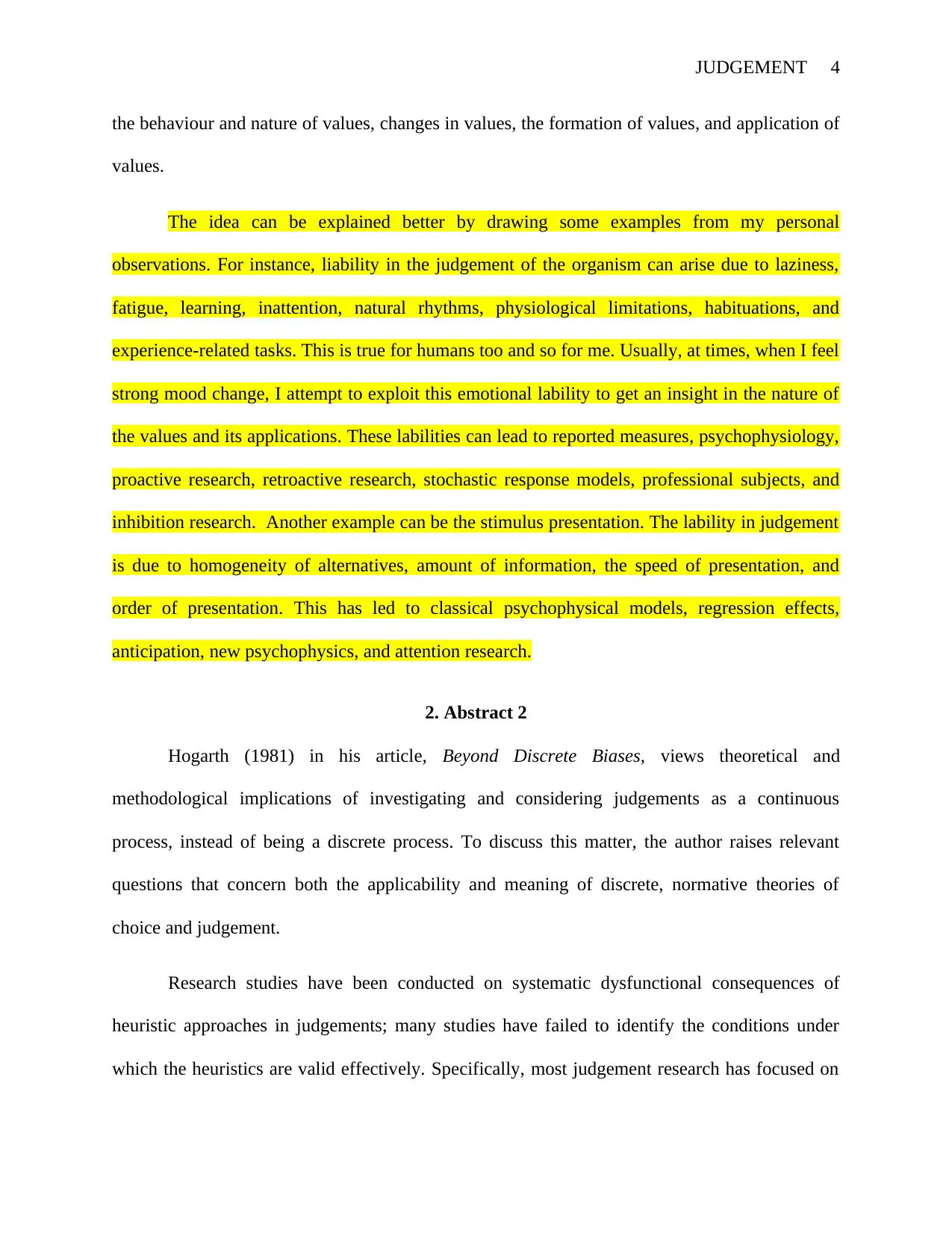
JUDGEMENT 4
the behaviour and nature of values, changes in values, the formation of values, and application of
values.
The idea can be explained better by drawing some examples from my personal
observations. For instance, liability in the judgement of the organism can arise due to laziness,
fatigue, learning, inattention, natural rhythms, physiological limitations, habituations, and
experience-related tasks. This is true for humans too and so for me. Usually, at times, when I feel
strong mood change, I attempt to exploit this emotional lability to get an insight in the nature of
the values and its applications. These labilities can lead to reported measures, psychophysiology,
proactive research, retroactive research, stochastic response models, professional subjects, and
inhibition research. Another example can be the stimulus presentation. The lability in judgement
is due to homogeneity of alternatives, amount of information, the speed of presentation, and
order of presentation. This has led to classical psychophysical models, regression effects,
anticipation, new psychophysics, and attention research.
2. Abstract 2
Hogarth (1981) in his article, Beyond Discrete Biases, views theoretical and
methodological implications of investigating and considering judgements as a continuous
process, instead of being a discrete process. To discuss this matter, the author raises relevant
questions that concern both the applicability and meaning of discrete, normative theories of
choice and judgement.
Research studies have been conducted on systematic dysfunctional consequences of
heuristic approaches in judgements; many studies have failed to identify the conditions under
which the heuristics are valid effectively. Specifically, most judgement research has focused on
the behaviour and nature of values, changes in values, the formation of values, and application of
values.
The idea can be explained better by drawing some examples from my personal
observations. For instance, liability in the judgement of the organism can arise due to laziness,
fatigue, learning, inattention, natural rhythms, physiological limitations, habituations, and
experience-related tasks. This is true for humans too and so for me. Usually, at times, when I feel
strong mood change, I attempt to exploit this emotional lability to get an insight in the nature of
the values and its applications. These labilities can lead to reported measures, psychophysiology,
proactive research, retroactive research, stochastic response models, professional subjects, and
inhibition research. Another example can be the stimulus presentation. The lability in judgement
is due to homogeneity of alternatives, amount of information, the speed of presentation, and
order of presentation. This has led to classical psychophysical models, regression effects,
anticipation, new psychophysics, and attention research.
2. Abstract 2
Hogarth (1981) in his article, Beyond Discrete Biases, views theoretical and
methodological implications of investigating and considering judgements as a continuous
process, instead of being a discrete process. To discuss this matter, the author raises relevant
questions that concern both the applicability and meaning of discrete, normative theories of
choice and judgement.
Research studies have been conducted on systematic dysfunctional consequences of
heuristic approaches in judgements; many studies have failed to identify the conditions under
which the heuristics are valid effectively. Specifically, most judgement research has focused on
Paraphrase This Document
Need a fresh take? Get an instant paraphrase of this document with our AI Paraphraser
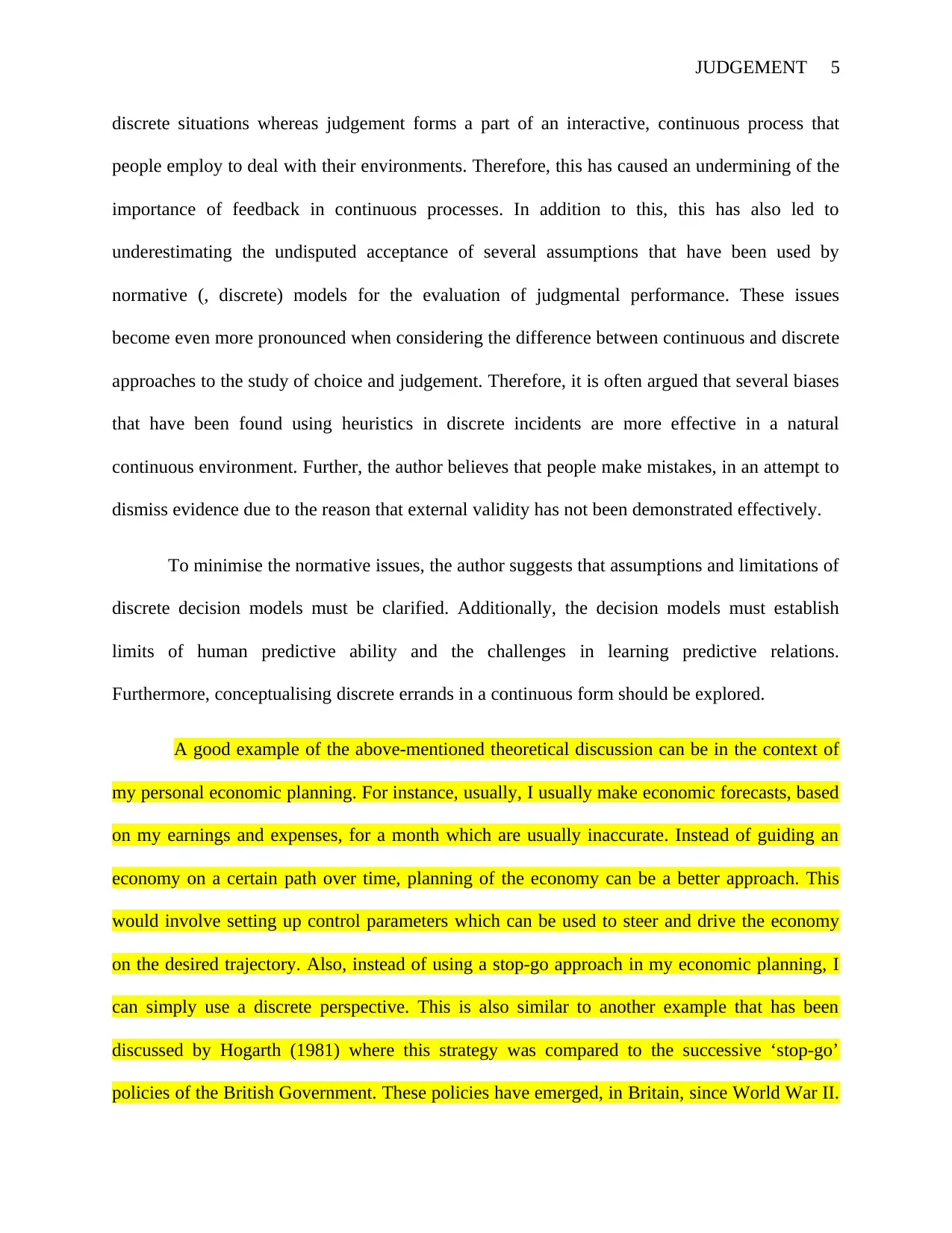
JUDGEMENT 5
discrete situations whereas judgement forms a part of an interactive, continuous process that
people employ to deal with their environments. Therefore, this has caused an undermining of the
importance of feedback in continuous processes. In addition to this, this has also led to
underestimating the undisputed acceptance of several assumptions that have been used by
normative (, discrete) models for the evaluation of judgmental performance. These issues
become even more pronounced when considering the difference between continuous and discrete
approaches to the study of choice and judgement. Therefore, it is often argued that several biases
that have been found using heuristics in discrete incidents are more effective in a natural
continuous environment. Further, the author believes that people make mistakes, in an attempt to
dismiss evidence due to the reason that external validity has not been demonstrated effectively.
To minimise the normative issues, the author suggests that assumptions and limitations of
discrete decision models must be clarified. Additionally, the decision models must establish
limits of human predictive ability and the challenges in learning predictive relations.
Furthermore, conceptualising discrete errands in a continuous form should be explored.
A good example of the above-mentioned theoretical discussion can be in the context of
my personal economic planning. For instance, usually, I usually make economic forecasts, based
on my earnings and expenses, for a month which are usually inaccurate. Instead of guiding an
economy on a certain path over time, planning of the economy can be a better approach. This
would involve setting up control parameters which can be used to steer and drive the economy
on the desired trajectory. Also, instead of using a stop-go approach in my economic planning, I
can simply use a discrete perspective. This is also similar to another example that has been
discussed by Hogarth (1981) where this strategy was compared to the successive ‘stop-go’
policies of the British Government. These policies have emerged, in Britain, since World War II.
discrete situations whereas judgement forms a part of an interactive, continuous process that
people employ to deal with their environments. Therefore, this has caused an undermining of the
importance of feedback in continuous processes. In addition to this, this has also led to
underestimating the undisputed acceptance of several assumptions that have been used by
normative (, discrete) models for the evaluation of judgmental performance. These issues
become even more pronounced when considering the difference between continuous and discrete
approaches to the study of choice and judgement. Therefore, it is often argued that several biases
that have been found using heuristics in discrete incidents are more effective in a natural
continuous environment. Further, the author believes that people make mistakes, in an attempt to
dismiss evidence due to the reason that external validity has not been demonstrated effectively.
To minimise the normative issues, the author suggests that assumptions and limitations of
discrete decision models must be clarified. Additionally, the decision models must establish
limits of human predictive ability and the challenges in learning predictive relations.
Furthermore, conceptualising discrete errands in a continuous form should be explored.
A good example of the above-mentioned theoretical discussion can be in the context of
my personal economic planning. For instance, usually, I usually make economic forecasts, based
on my earnings and expenses, for a month which are usually inaccurate. Instead of guiding an
economy on a certain path over time, planning of the economy can be a better approach. This
would involve setting up control parameters which can be used to steer and drive the economy
on the desired trajectory. Also, instead of using a stop-go approach in my economic planning, I
can simply use a discrete perspective. This is also similar to another example that has been
discussed by Hogarth (1981) where this strategy was compared to the successive ‘stop-go’
policies of the British Government. These policies have emerged, in Britain, since World War II.
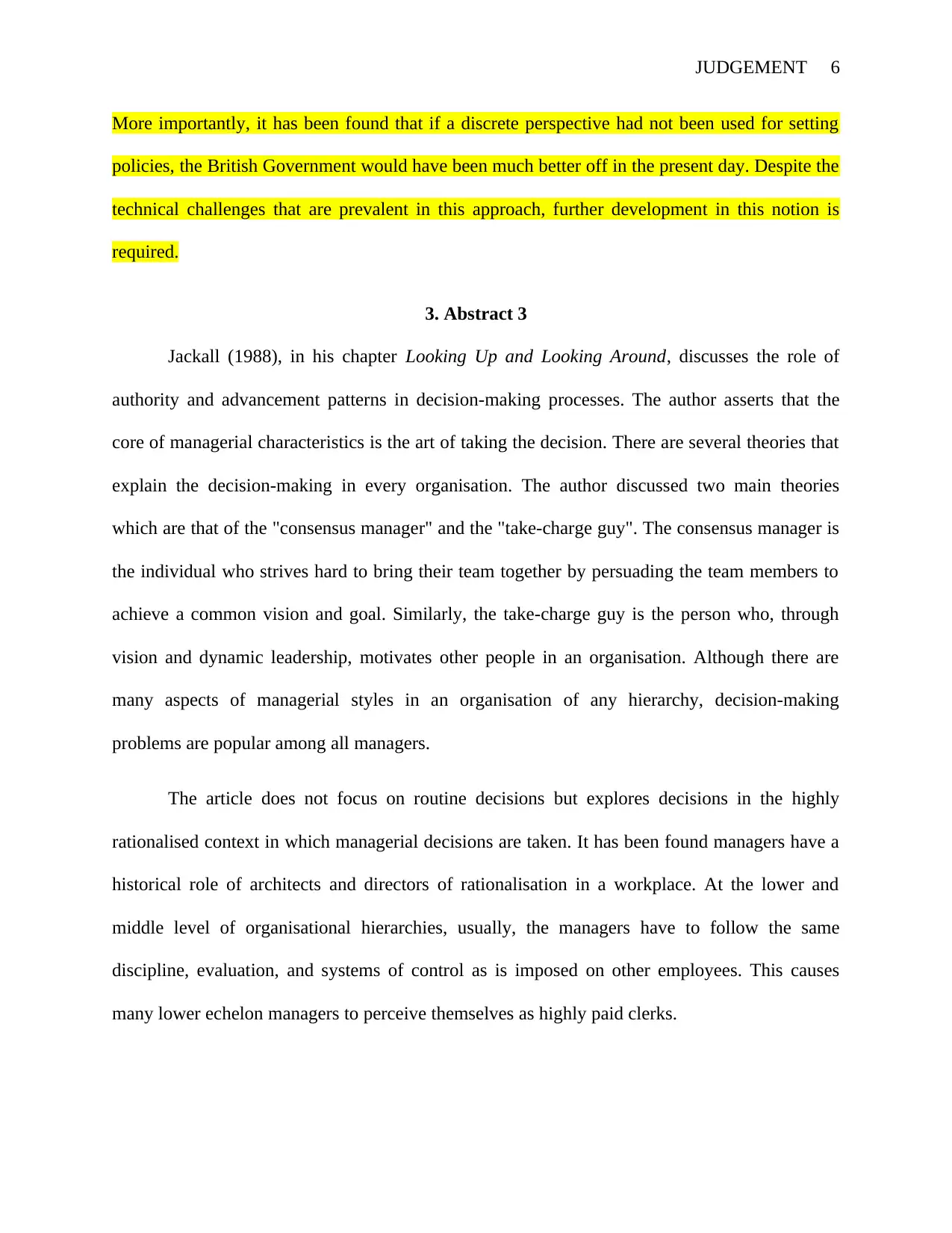
JUDGEMENT 6
More importantly, it has been found that if a discrete perspective had not been used for setting
policies, the British Government would have been much better off in the present day. Despite the
technical challenges that are prevalent in this approach, further development in this notion is
required.
3. Abstract 3
Jackall (1988), in his chapter Looking Up and Looking Around, discusses the role of
authority and advancement patterns in decision-making processes. The author asserts that the
core of managerial characteristics is the art of taking the decision. There are several theories that
explain the decision-making in every organisation. The author discussed two main theories
which are that of the "consensus manager" and the "take-charge guy". The consensus manager is
the individual who strives hard to bring their team together by persuading the team members to
achieve a common vision and goal. Similarly, the take-charge guy is the person who, through
vision and dynamic leadership, motivates other people in an organisation. Although there are
many aspects of managerial styles in an organisation of any hierarchy, decision-making
problems are popular among all managers.
The article does not focus on routine decisions but explores decisions in the highly
rationalised context in which managerial decisions are taken. It has been found managers have a
historical role of architects and directors of rationalisation in a workplace. At the lower and
middle level of organisational hierarchies, usually, the managers have to follow the same
discipline, evaluation, and systems of control as is imposed on other employees. This causes
many lower echelon managers to perceive themselves as highly paid clerks.
More importantly, it has been found that if a discrete perspective had not been used for setting
policies, the British Government would have been much better off in the present day. Despite the
technical challenges that are prevalent in this approach, further development in this notion is
required.
3. Abstract 3
Jackall (1988), in his chapter Looking Up and Looking Around, discusses the role of
authority and advancement patterns in decision-making processes. The author asserts that the
core of managerial characteristics is the art of taking the decision. There are several theories that
explain the decision-making in every organisation. The author discussed two main theories
which are that of the "consensus manager" and the "take-charge guy". The consensus manager is
the individual who strives hard to bring their team together by persuading the team members to
achieve a common vision and goal. Similarly, the take-charge guy is the person who, through
vision and dynamic leadership, motivates other people in an organisation. Although there are
many aspects of managerial styles in an organisation of any hierarchy, decision-making
problems are popular among all managers.
The article does not focus on routine decisions but explores decisions in the highly
rationalised context in which managerial decisions are taken. It has been found managers have a
historical role of architects and directors of rationalisation in a workplace. At the lower and
middle level of organisational hierarchies, usually, the managers have to follow the same
discipline, evaluation, and systems of control as is imposed on other employees. This causes
many lower echelon managers to perceive themselves as highly paid clerks.
⊘ This is a preview!⊘
Do you want full access?
Subscribe today to unlock all pages.

Trusted by 1+ million students worldwide
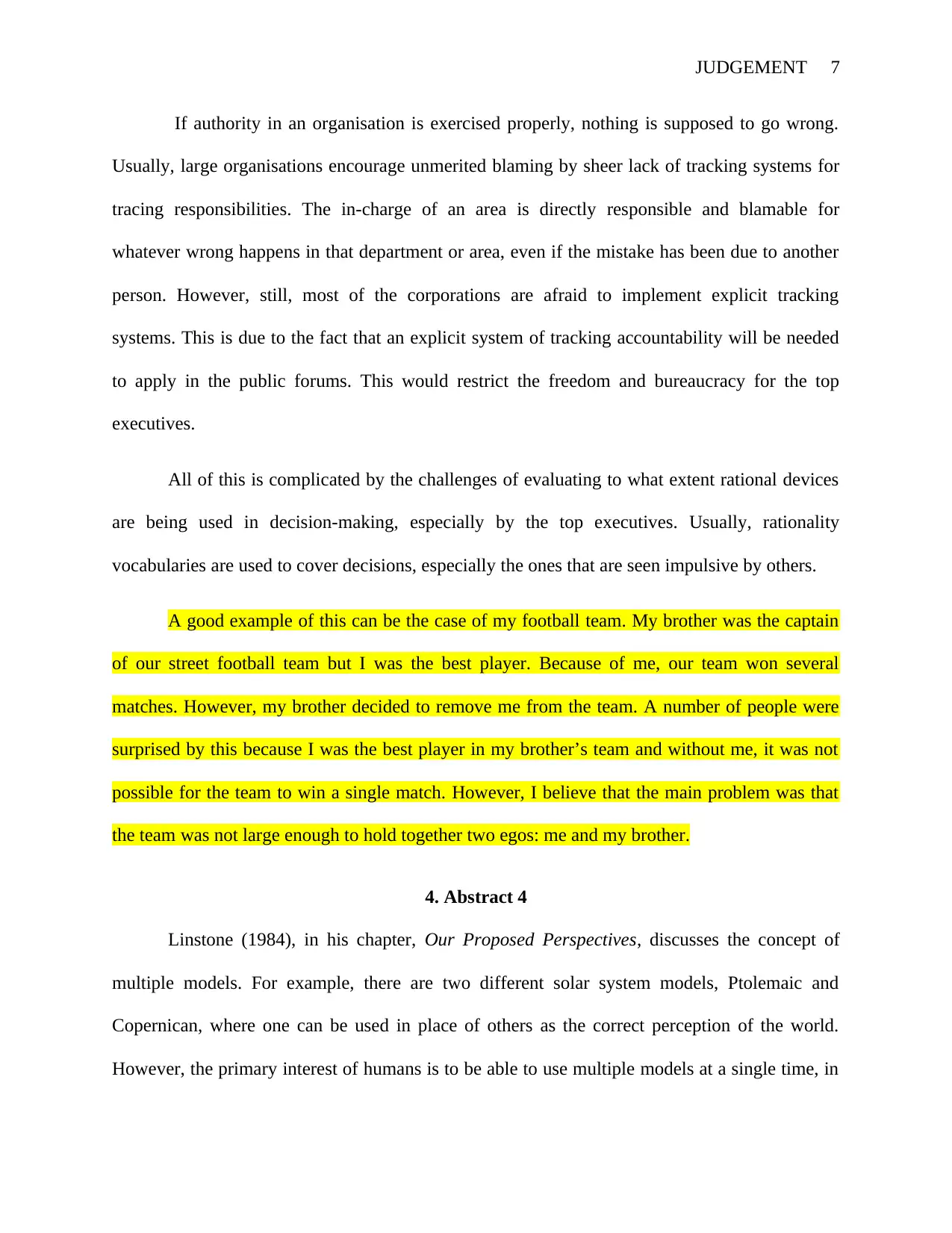
JUDGEMENT 7
If authority in an organisation is exercised properly, nothing is supposed to go wrong.
Usually, large organisations encourage unmerited blaming by sheer lack of tracking systems for
tracing responsibilities. The in-charge of an area is directly responsible and blamable for
whatever wrong happens in that department or area, even if the mistake has been due to another
person. However, still, most of the corporations are afraid to implement explicit tracking
systems. This is due to the fact that an explicit system of tracking accountability will be needed
to apply in the public forums. This would restrict the freedom and bureaucracy for the top
executives.
All of this is complicated by the challenges of evaluating to what extent rational devices
are being used in decision-making, especially by the top executives. Usually, rationality
vocabularies are used to cover decisions, especially the ones that are seen impulsive by others.
A good example of this can be the case of my football team. My brother was the captain
of our street football team but I was the best player. Because of me, our team won several
matches. However, my brother decided to remove me from the team. A number of people were
surprised by this because I was the best player in my brother’s team and without me, it was not
possible for the team to win a single match. However, I believe that the main problem was that
the team was not large enough to hold together two egos: me and my brother.
4. Abstract 4
Linstone (1984), in his chapter, Our Proposed Perspectives, discusses the concept of
multiple models. For example, there are two different solar system models, Ptolemaic and
Copernican, where one can be used in place of others as the correct perception of the world.
However, the primary interest of humans is to be able to use multiple models at a single time, in
If authority in an organisation is exercised properly, nothing is supposed to go wrong.
Usually, large organisations encourage unmerited blaming by sheer lack of tracking systems for
tracing responsibilities. The in-charge of an area is directly responsible and blamable for
whatever wrong happens in that department or area, even if the mistake has been due to another
person. However, still, most of the corporations are afraid to implement explicit tracking
systems. This is due to the fact that an explicit system of tracking accountability will be needed
to apply in the public forums. This would restrict the freedom and bureaucracy for the top
executives.
All of this is complicated by the challenges of evaluating to what extent rational devices
are being used in decision-making, especially by the top executives. Usually, rationality
vocabularies are used to cover decisions, especially the ones that are seen impulsive by others.
A good example of this can be the case of my football team. My brother was the captain
of our street football team but I was the best player. Because of me, our team won several
matches. However, my brother decided to remove me from the team. A number of people were
surprised by this because I was the best player in my brother’s team and without me, it was not
possible for the team to win a single match. However, I believe that the main problem was that
the team was not large enough to hold together two egos: me and my brother.
4. Abstract 4
Linstone (1984), in his chapter, Our Proposed Perspectives, discusses the concept of
multiple models. For example, there are two different solar system models, Ptolemaic and
Copernican, where one can be used in place of others as the correct perception of the world.
However, the primary interest of humans is to be able to use multiple models at a single time, in
Paraphrase This Document
Need a fresh take? Get an instant paraphrase of this document with our AI Paraphraser
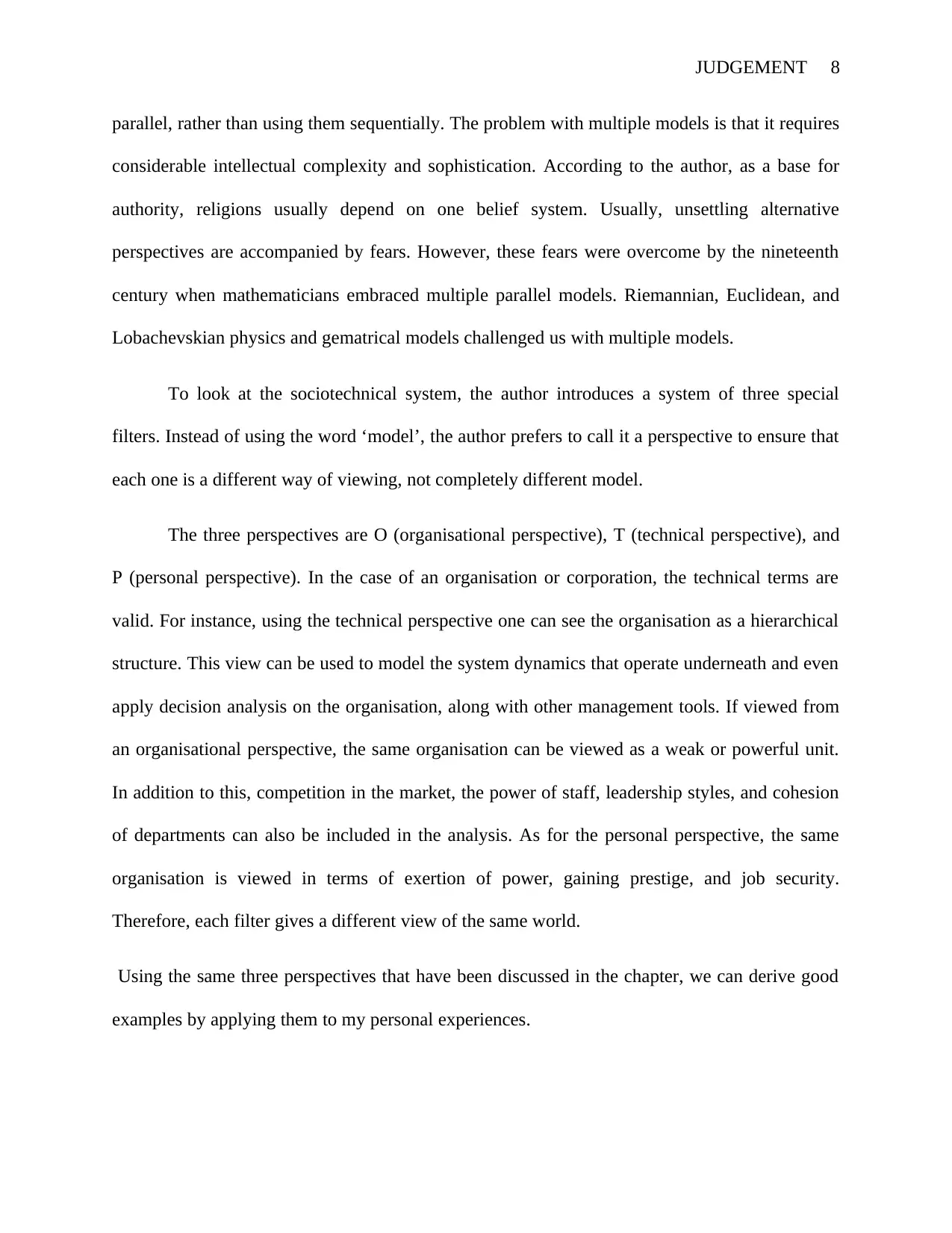
JUDGEMENT 8
parallel, rather than using them sequentially. The problem with multiple models is that it requires
considerable intellectual complexity and sophistication. According to the author, as a base for
authority, religions usually depend on one belief system. Usually, unsettling alternative
perspectives are accompanied by fears. However, these fears were overcome by the nineteenth
century when mathematicians embraced multiple parallel models. Riemannian, Euclidean, and
Lobachevskian physics and gematrical models challenged us with multiple models.
To look at the sociotechnical system, the author introduces a system of three special
filters. Instead of using the word ‘model’, the author prefers to call it a perspective to ensure that
each one is a different way of viewing, not completely different model.
The three perspectives are O (organisational perspective), T (technical perspective), and
P (personal perspective). In the case of an organisation or corporation, the technical terms are
valid. For instance, using the technical perspective one can see the organisation as a hierarchical
structure. This view can be used to model the system dynamics that operate underneath and even
apply decision analysis on the organisation, along with other management tools. If viewed from
an organisational perspective, the same organisation can be viewed as a weak or powerful unit.
In addition to this, competition in the market, the power of staff, leadership styles, and cohesion
of departments can also be included in the analysis. As for the personal perspective, the same
organisation is viewed in terms of exertion of power, gaining prestige, and job security.
Therefore, each filter gives a different view of the same world.
Using the same three perspectives that have been discussed in the chapter, we can derive good
examples by applying them to my personal experiences.
parallel, rather than using them sequentially. The problem with multiple models is that it requires
considerable intellectual complexity and sophistication. According to the author, as a base for
authority, religions usually depend on one belief system. Usually, unsettling alternative
perspectives are accompanied by fears. However, these fears were overcome by the nineteenth
century when mathematicians embraced multiple parallel models. Riemannian, Euclidean, and
Lobachevskian physics and gematrical models challenged us with multiple models.
To look at the sociotechnical system, the author introduces a system of three special
filters. Instead of using the word ‘model’, the author prefers to call it a perspective to ensure that
each one is a different way of viewing, not completely different model.
The three perspectives are O (organisational perspective), T (technical perspective), and
P (personal perspective). In the case of an organisation or corporation, the technical terms are
valid. For instance, using the technical perspective one can see the organisation as a hierarchical
structure. This view can be used to model the system dynamics that operate underneath and even
apply decision analysis on the organisation, along with other management tools. If viewed from
an organisational perspective, the same organisation can be viewed as a weak or powerful unit.
In addition to this, competition in the market, the power of staff, leadership styles, and cohesion
of departments can also be included in the analysis. As for the personal perspective, the same
organisation is viewed in terms of exertion of power, gaining prestige, and job security.
Therefore, each filter gives a different view of the same world.
Using the same three perspectives that have been discussed in the chapter, we can derive good
examples by applying them to my personal experiences.

JUDGEMENT 9
For example, I see myself as highly T-oriented. This might have to do with the culture, family,
and environment too. My father is a politician so he loves polls and stats. Moreover, I am a
baseball fan so I am also awash in statistics. My mother is also a government employee and likes
to define the quality of life in terms of numerical figures. Therefore, I can say that I belong to a
T-oriented culture.
Similarly, as for the O perspective, I have seen several boys in schools who form a gang
and think themselves as superior to other ones, through his myth of racial superiority or
socioeconomic status. Using their charisma, boys like to transform the P perspective into an O
perspective, which they use to intimidate other students in the school. This leads to the creation
of common illusions and ludicrous doctrines about bullies’ strength and physical characteristics.
This is similar to the O perspective as defined by the author since it assists the members of the
school gang in taking decisions whether it corresponded with the standards of the outsiders or
not.
For example, I see myself as highly T-oriented. This might have to do with the culture, family,
and environment too. My father is a politician so he loves polls and stats. Moreover, I am a
baseball fan so I am also awash in statistics. My mother is also a government employee and likes
to define the quality of life in terms of numerical figures. Therefore, I can say that I belong to a
T-oriented culture.
Similarly, as for the O perspective, I have seen several boys in schools who form a gang
and think themselves as superior to other ones, through his myth of racial superiority or
socioeconomic status. Using their charisma, boys like to transform the P perspective into an O
perspective, which they use to intimidate other students in the school. This leads to the creation
of common illusions and ludicrous doctrines about bullies’ strength and physical characteristics.
This is similar to the O perspective as defined by the author since it assists the members of the
school gang in taking decisions whether it corresponded with the standards of the outsiders or
not.
⊘ This is a preview!⊘
Do you want full access?
Subscribe today to unlock all pages.

Trusted by 1+ million students worldwide
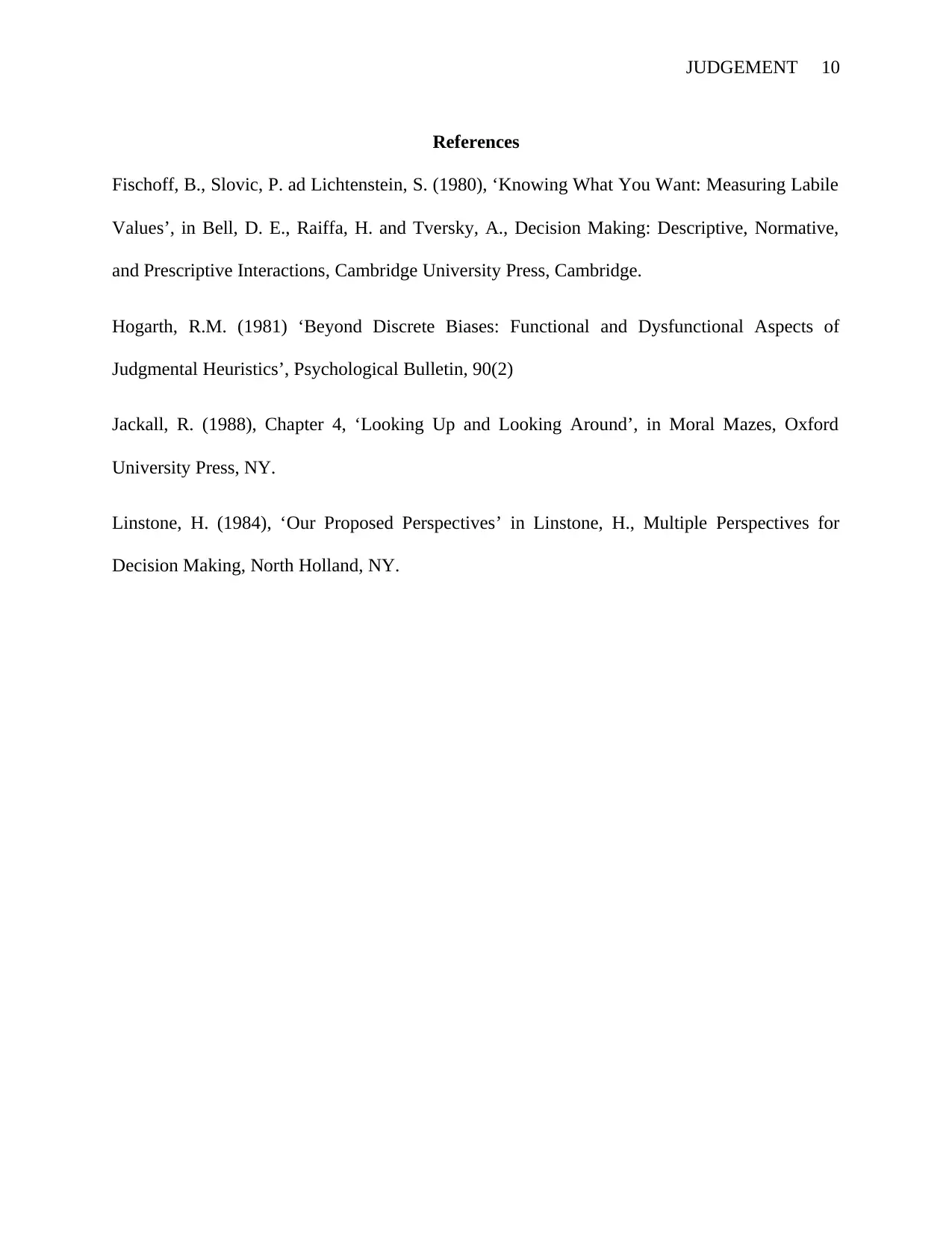
JUDGEMENT 10
References
Fischoff, B., Slovic, P. ad Lichtenstein, S. (1980), ‘Knowing What You Want: Measuring Labile
Values’, in Bell, D. E., Raiffa, H. and Tversky, A., Decision Making: Descriptive, Normative,
and Prescriptive Interactions, Cambridge University Press, Cambridge.
Hogarth, R.M. (1981) ‘Beyond Discrete Biases: Functional and Dysfunctional Aspects of
Judgmental Heuristics’, Psychological Bulletin, 90(2)
Jackall, R. (1988), Chapter 4, ‘Looking Up and Looking Around’, in Moral Mazes, Oxford
University Press, NY.
Linstone, H. (1984), ‘Our Proposed Perspectives’ in Linstone, H., Multiple Perspectives for
Decision Making, North Holland, NY.
References
Fischoff, B., Slovic, P. ad Lichtenstein, S. (1980), ‘Knowing What You Want: Measuring Labile
Values’, in Bell, D. E., Raiffa, H. and Tversky, A., Decision Making: Descriptive, Normative,
and Prescriptive Interactions, Cambridge University Press, Cambridge.
Hogarth, R.M. (1981) ‘Beyond Discrete Biases: Functional and Dysfunctional Aspects of
Judgmental Heuristics’, Psychological Bulletin, 90(2)
Jackall, R. (1988), Chapter 4, ‘Looking Up and Looking Around’, in Moral Mazes, Oxford
University Press, NY.
Linstone, H. (1984), ‘Our Proposed Perspectives’ in Linstone, H., Multiple Perspectives for
Decision Making, North Holland, NY.
1 out of 10
Your All-in-One AI-Powered Toolkit for Academic Success.
+13062052269
info@desklib.com
Available 24*7 on WhatsApp / Email
![[object Object]](/_next/static/media/star-bottom.7253800d.svg)
Unlock your academic potential
Copyright © 2020–2025 A2Z Services. All Rights Reserved. Developed and managed by ZUCOL.
